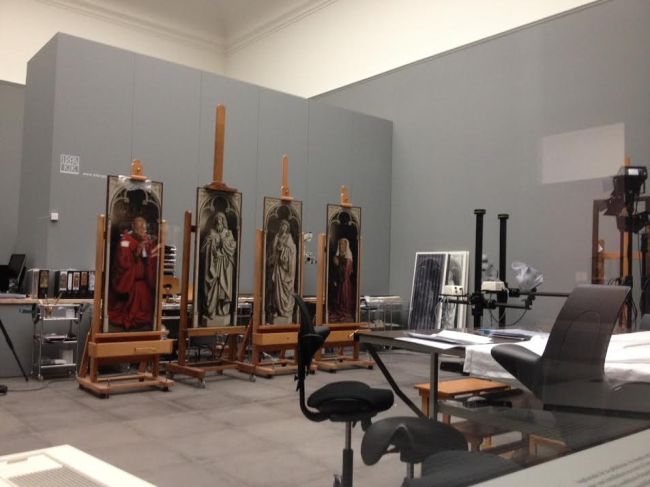I was able to go to NYC for a brief weekend visit in January 2014. The sole reason for the visit was to the see the Armory Show at the New York Historical Society (tickets for the Girl with the Pearl Earring were all sold out). I did not take pics of the show, but did get some of the Luce Center on the top floor of the NYHS. Also not many pics of the High Line, but two pieces of art that I instantly thought worth photographing were a large billboard and a sculpture.
Monthly Archives: March 2014

Where did these photos come from?
I’m just back from Belgium where I definitely didn’t take these pictures of Jan van Eyck’s “Adoration of the Mystic Lamb” aka “The Lamb of God” aka “The Ghent Altarpiece” panels in the conservation center of the Museum of Fines Arts Gent
No way, wasn’t me. But I did go see the panels at said museum (which is definitely worth the visit btw, the museum collection was wonderful!). If you’ve ever taken an Art History course, you are probably intimately familiar with the Ghent Altarpiece. Suspected to be the first oil painting and history of high profile thefts, it’s one of your standard 101 pieces. Having seen the work myself (both at the Museum of Fine Arts and in situ at St Bavo Cathedral) I get the hype. It’s a beautiful painting. Also it’s huge, maybe 10×20 ft. The figures are just under life size.
The Museum of Fine Arts Gent along with the Getty Foundation have done a great job of making the altarpiece accessible to the public online. You can checkout Closer to Van Eyck if a trip to Belgium isn’t in the cards.
So sweet
Vik Muniz uses humor to lure his audience in. “Humor and visual gimmicks operate at the most basic level of art appreciation. They create physical and perceptual responses that hold the viewer in front of the work a bit longer than usual. Once you achieve this tenacity, you can afford to be deep and erudite.” (Muniz, Vik. Reflex p. 19). The chocolate drip painting is a good example of Muniz’s humor at work. Teresa Annas points to the “Action Photo II (Jackson Pollock)” image in her The Virginian Pilot January 30th review of the Vik Muniz: Poetics of Perception show at the Virginia Museum of Modern Art. “He also used syrup, humorously so, to mimic abstract expressionist Jackson Pollock in the act of creating an ‘action’ painting, as famously captured by photographer Hans Namuth.”



I had a chance to see the show last weekend. It was the first time I’ve seen a group of Muniz’s work displayed together, and even though there were no Verso examples present, the show was definitely worth going to. The exhibition included images from the Pictures of Chocolate, Junk and Garbage photographs, Pictures of Magazines, Earthworks, Pictures of Color, Equivalents, Diamond divas, and a Medusa plate.
Seeing the large scale Pictures of Junk photograph “Vulcan Forges Cupid’s Arrows” was a highlight. The image definitely plays with perspective and perception as you move away from and towards the image. From far away the mythic image is what your eye is drawn to, but as you get closer to the photograph you start to focus on the materials themselves. It’s a flat image but the sensation of depth is there. I felt a sense of vertigo and could imagine standing high above the installation looking down at it. I found myself drawn to the individual items much more than I expected to. There is a fan, nets, tires, small red plastic items clustered together, rope, musical instruments, and so much more. There is a huge variety of textures and materials that from far away congeal together with their muted colors. Close up the spots of reds, blues, and yellows stand out and keep the eye moving around the image.
Other standouts for me were the Diamond images, mainly because diamonds seem so difficult to photograph, and also the Pictures of Magazines, again because in person it really allows to you move between the overall illusionistic image and the small details that appear in the materials themselves.

Virginia Beach, view from the hotel, not a bad place to do research!
Subject matters
By placing art out of the gallery it exists removed from its expected context. A lifelike sculpture out of the gallery is also a deviation from the form many think of when they think of public art – it seems large metal sculptures are more appropriate in landscapes than mostly naked men, especially if the landscape is a college campus. This sleep walker is probably trying to find his way back to the museum.
In the introduction to the 1999 exhibition catalog, Abracadabra: International Contemporary Art, Catherine Kinley explains the fascination between the real and the artificial. “This publicly personal art challenges assumptions about the power of the virtual over the real in a world where it is thought increasingly difficult to distinguish one from the other. A decade ago, artists had begun to doubt that the real could still be easily identified. Their art was made in the context of propositions by post-modern critics and philosophers who were examining the effects of the proliferation of electronic media and the power of the information explosion. In the 1950s and 1960s advertising and film, earlier manifestations of the information age, had been co-opted and celebrated by artists. Later, television, video and computers offered new possibilites for art but were also seen as having the power to dull ‘real’ experience and to fuse the real and the imaginary. The palpable world appeared impenetrable and opaque. A common response – whether a symptom of resignation or a strategic act of alliance – was to mimic this new artificiality.”













